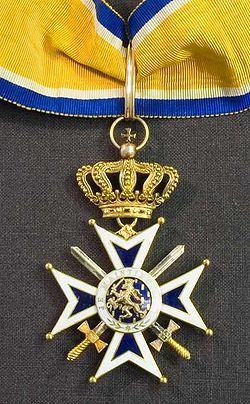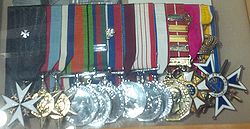Order of Orange-Nassau
During World War II, the Order of Orange-Nassau was bestowed upon both members of the Netherlands military and members of foreign services who had helped liberate the Netherlands from Nazi German occupation, and those who helped liberate the former Dutch colonies in the Pacific. In the modern age, the Orange-Nassau is still the most active civil and military decoration of the Netherlands, and ranks after the Order of the Netherlands Lion. The order is typically awarded each year on the Monarch's official birthday (currently April 27) with around 3500 appointments to the order made public. The order is also used to honour foreign princes, ministers, dignitaries and diplomats.
The Order of Orange-Nassau has two divisions, civil and military, the former denoted by a wreath of laurel on the badges, and the latter by crossed swords on both the badges and the stars. Until 1996, the Order of Orange-Nassau consisted of five grades: Knight Grand Cross, Grand Officer, Commander, Officer, and Knight with additional honourary medals issued. After 1996, the honourary medals were replaced with a sixth grade, Member.
Insignia
The badge of the order is a blue-enamelled, white enamel-bordered Maltese Cross, in gilt for the officers and above, in silver for knights and members. The obverse central disc displays the King's coat of arms in gold and blue enamel, surrounded by a white enamel ring bearing the national motto Je Maintiendrai (I shall maintain). The reverse central disc has the crowned monogram "W" (for Queen Wilhelmina) surrounded by the motto God Zij Met Ons (God be with us). The badge hangs from a royal crown. The civil division has a wreath of laurel between the arms of the cross; the military division has crossed swords instead. For the grades of Knight and Member, the badges are made of silver. For the other grades, the silver is gilded. For the grades of Knight Grand Cross, Grand Officer and Commander, the badges have a diameter of 60 mm. For the grades of Officer and Knight, they have a diameter of 46 mm. For the grade of Member, a diameter of 35 mm. The badge is attached to a ribbon which is orange with white and blue border stripes. The way the badge and ribbon should be worn differs between men and women.The star of the order is a silver star with straight rays, in 8 points for Grand Cross and in 4 points for Grand Officer; the central disc has the King's arms in gold and blue enamel, surrounded by a white enamel ring bearing the Dutch national motto Je Maintiendrai. The military division has crossed swords.
- Knight Grand Cross - badge may be worn on a sash on the right shoulder, plus an 8-pointed star on the left chest;
- Grand Officer - badge may be worn by men on a necklet, and by women worn on a ribbon tied as a bow at the left chest. Also a 4-pointed star is worn on the left chest;
- Commander - badge may be worn by men on a necklet, and by women worn on a ribbon tied as a bow at the left chest;
- Officer - wears the badge on a ribbon with a rosette on the left chest;
- Knight - wears the badge on a ribbon on the left chest;
- Member - wears a smaller badge on a ribbon on the left chest.
Issued
There have been 9 Signals recipients of the Order of Orange Nassau. Please see Order of Orange-Nassau - Signals Recipients for a listing of the individuals.

